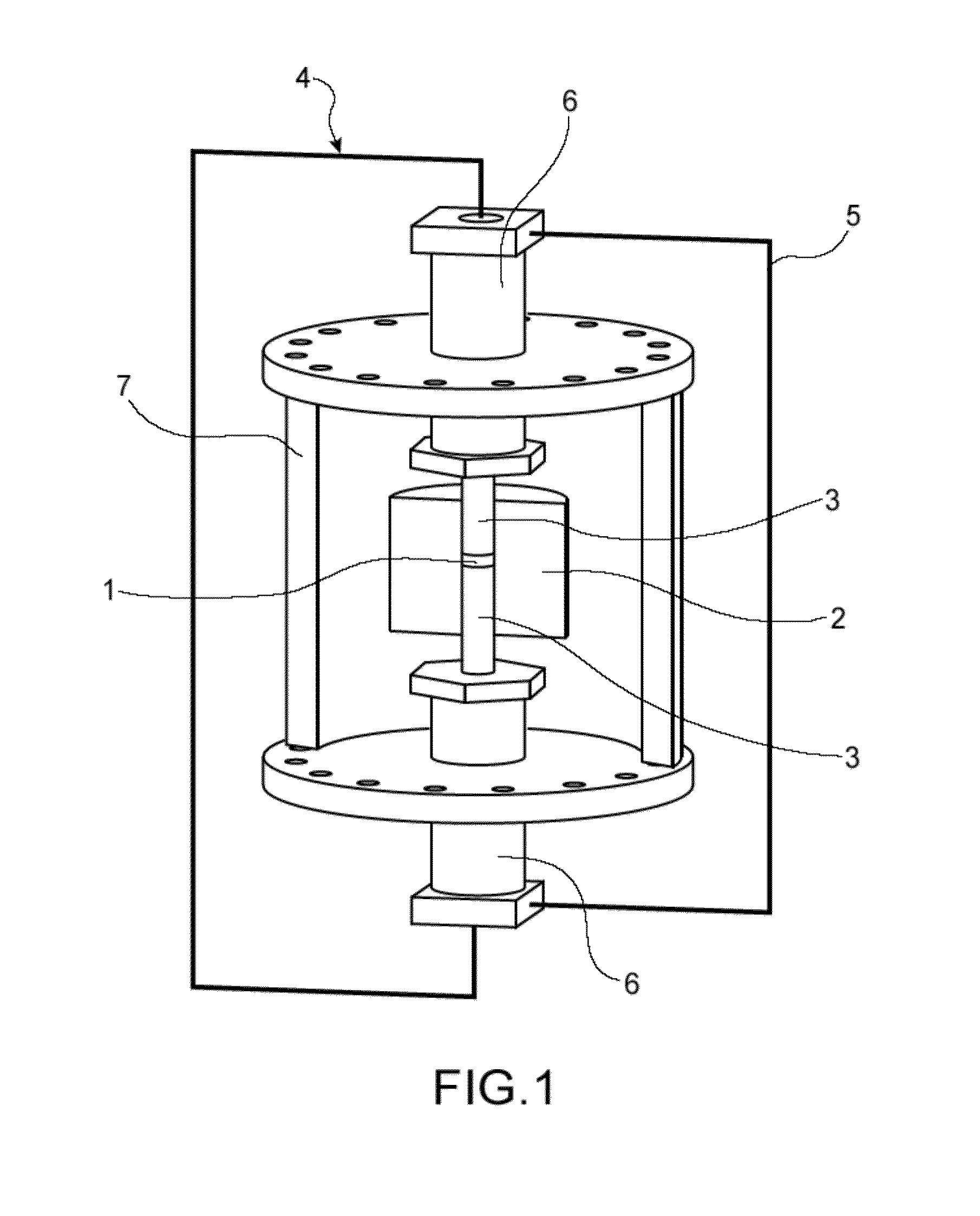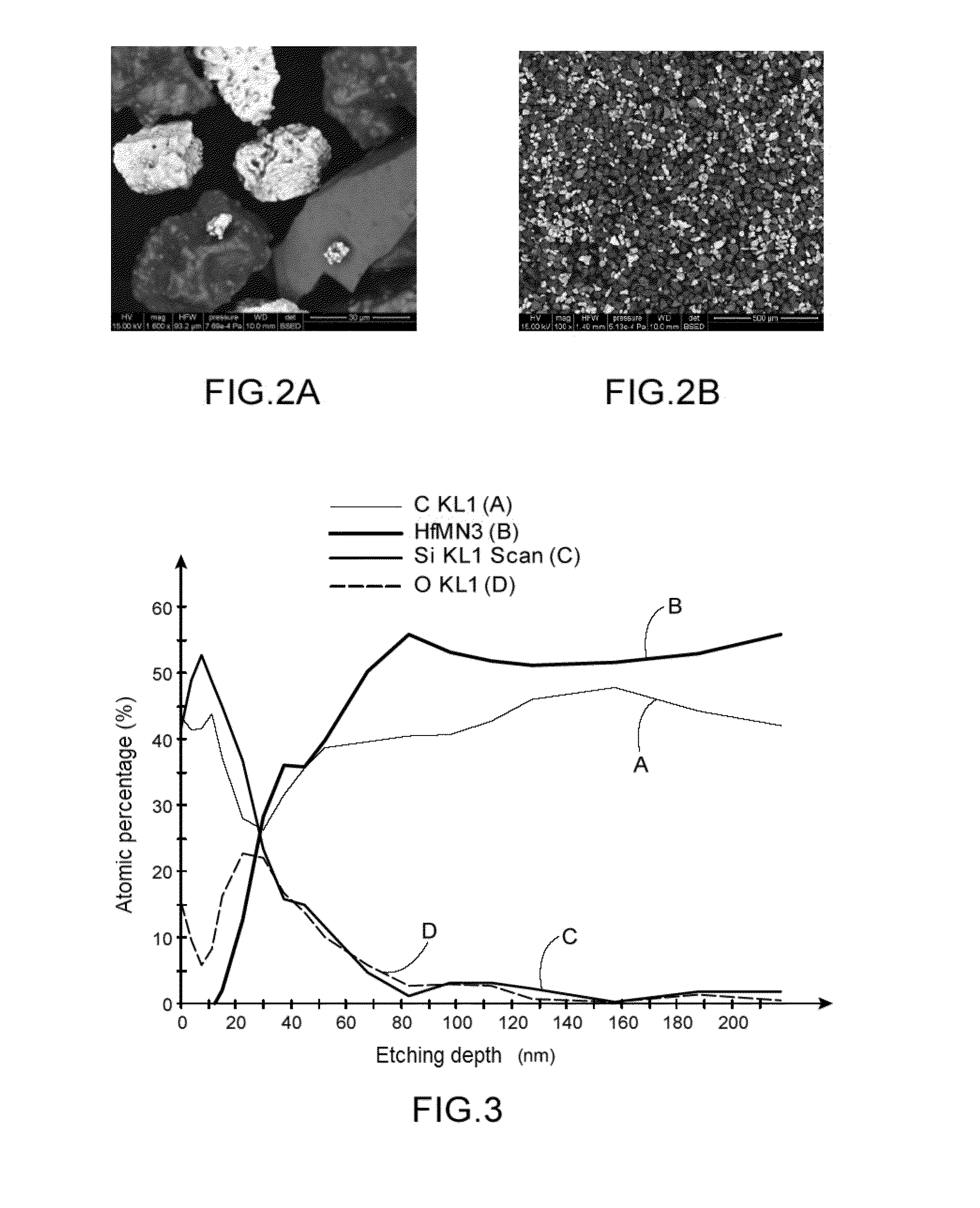Process for coating a part with an oxidation-protective coating
- Summary
- Abstract
- Description
- Claims
- Application Information
AI Technical Summary
Benefits of technology
Problems solved by technology
Method used
Image
Examples
example 1
[0283]In this example, a protective coating against oxidation (PAO) is prepared by SPS sintering of a hafnium carbide (HfC) powder coated with silicon carbide (SiC), on a carbonaceous substrate.
[0284]The HfC powder coated with SiC is prepared from an initial HfC powder which has a d50 of 35 μm.
[0285]The SiC coating of the powder is achieved by chemical vapor deposition (CVD) in a fluidized bed.
[0286]Hexamethyldisilane is used as a precursor of SiC for promoting deposition of SiC on the HfC powder.
[0287]The deposition operation is carried out under hydrogen (which plays a transport and reduction role) and under nitrogen (which plays the role of a fluidization gas) at about 900° C.
[0288]The deposition operation lasts for about 1 day taking into account the rise and the decrease of the temperature.
[0289]One of the benefits of the HfC powder coated with SiC stems from the fine adjustment between the coefficients of expansion of SiC, of HfC and of the substrate.
[0290]The benefit of SiC i...
example 2
[0314]In this example, a protective coating against oxidation (PAO) is prepared by SPS sintering of a hafnium carbide (HfC) powder coated with silicon carbide (SiC), coated with Ti, on a carbonaceous substrate.
[0315]The hafnium carbide (HfC) powder coated with silicon carbide (SiC), coated with Ti, is prepared by coating with titanium the hafnium carbide (HfC) powder coated with silicon carbide (SiC) prepared in Example 1.
[0316]The titanium carbide coating is made by chemical vapor deposition (CVD) in a fluidized bed.
[0317]The precursor used is titanium chloride, associated with a complexing agent.
[0318]The Ti layer with which the particles of the powder prepared in this example are provided, have a double benefit, i.e.:[0319]the titanium layer gives the possibility of facilitating sintering;[0320]during sintering, the titanium may carburize upon contact with the carbonaceous substrate so as to form TiC, a refractory carbide, and promote adhesion of the coating to the substrate.
[032...
example 3
[0353]In this example, thermogravimetric analyses (TGA) were conducted on the crude HfC powder (powder without any coating as described in Example 1) as well as on the HfC powder coated with SiC (prepared in Example 1) and on an SiC powder with a grain size d50=35 μm identical with the previous ones.
[0354]The analyzer is a thermobalance more exactly a mono-furnace SETARAM TG 92® apparatus equipped with a thermocouple of type S.
[0355]With sweeping of dry compressed air, the samples are positioned in a rod for Differential Scanning Calorimetry or DSC.
[0356]The maximum temperature reached is 1,500° C. and the rise kinetics are set to 10° C. / min.
[0357]FIG. 8 shows the time-dependent change of the mass gain versus temperature.
[0358]The mass gain is directly linked to oxidation, the greater the mass gain, the more the material is oxidized.
[0359]FIG. 8 shows a mass gain of more than 10% for crude HfC (Curve B) with oxidation which starts from 400° C. and which is disastrous between 500 and...
PUM
| Property | Measurement | Unit |
|---|---|---|
| Grain size | aaaaa | aaaaa |
| Grain size | aaaaa | aaaaa |
| Temperature | aaaaa | aaaaa |
Abstract
Description
Claims
Application Information
 Login to View More
Login to View More - R&D
- Intellectual Property
- Life Sciences
- Materials
- Tech Scout
- Unparalleled Data Quality
- Higher Quality Content
- 60% Fewer Hallucinations
Browse by: Latest US Patents, China's latest patents, Technical Efficacy Thesaurus, Application Domain, Technology Topic, Popular Technical Reports.
© 2025 PatSnap. All rights reserved.Legal|Privacy policy|Modern Slavery Act Transparency Statement|Sitemap|About US| Contact US: help@patsnap.com



